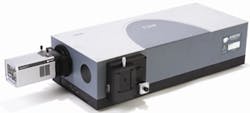Spectroscopy sniffs out fake spirits
Researchers at St. Andrew’s University (St. Andrews, Fife, Scotland) are using a microfluidic device coupled with a laser-based near-infrared (NIR) spectroscopy system to characterize whiskies and identify fakes.
Praveen Ashok, Kishan Dholakia, and Bavishna Praveen of the optical manipulation group at the university created the device that can detect counterfeit whiskey samples and characterize genuine samples by brand, age and, even cask.
Quality standardization for Scotch whiskey is assessed using alcohol content, color consistency and flavor. Low alcohol content is a primary indicator of fake whiskey, but the distinctive flavor -- which is determined by what is known as its “congener profile” -- is very difficult to mimic.
This profile is governed by organic compounds formed during fermentation and during maturation in wooden casks. Amounting to less than 1% of the total volume, these include organic acids, higher order alcohols, esters, and aldehydes and wood extracts, such as tannin, acid, and coloring matters.
The team used an optical fiber-based optofluidic chip to analyze 20-µL samples of commercially available single-malt whiskies using NIR spectroscopy. No sample preparation was involved, variation due to ethanol evaporation was eliminated by the confinement within the microfluidic channel and the analysis time was approximately two seconds.
Raman and fluorescence spectra were recorded by an Andor (Belfast, UK) Shamrock SR-303i spectrometer equipped with an Andor Newton DU920P BR-DD back-illuminated, thermoelectrically-cooled CCD camera.
"The Raman spectra of the whiskey samples is dominated by peaks corresponding to 40% ethanol, and the results demonstrate that the alcohol content may be predicted to a probability of more than 99%, enough to rapidly weed out the majority of fakes," says Ashok.
Although the congener components could not be distinguished from differences in the Raman peaks, the broad fluorescence background is markedly different for different types of whiskey due to the variation in congener profiles. The result is that whiskies can be successful classified based upon their age, origin, and cask.
While the Raman microfluidics technique will be of great interest for the liquid-processing industry, is also great news for whiskey aficionados around the world.
-- By Dave Wilson, Senior Editor, Vision Systems Design
